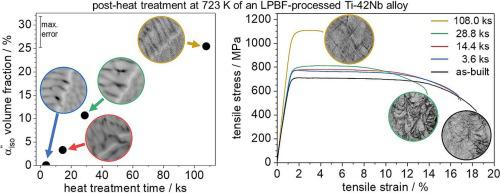当前位置:
X-MOL 学术
›
Mater. Des.
›
论文详情
Our official English website, www.x-mol.net, welcomes your feedback! (Note: you will need to create a separate account there.)
Tailoring microstructure and mechanical properties of an LPBF-processed beta Ti-Nb alloy through post-heat treatments
Materials & Design ( IF 8.4 ) Pub Date : 2024-02-24 , DOI: 10.1016/j.matdes.2024.112799 S. Pilz , M. Bönisch , A. Datye , S. Zhang , F. Günther , S. Drescher , U. Kühn , U.D. Schwarz , M. Zimmermann , A. Gebert
Materials & Design ( IF 8.4 ) Pub Date : 2024-02-24 , DOI: 10.1016/j.matdes.2024.112799 S. Pilz , M. Bönisch , A. Datye , S. Zhang , F. Günther , S. Drescher , U. Kühn , U.D. Schwarz , M. Zimmermann , A. Gebert

|
This study provides a comprehensive analysis of a Ti‑42Nb alloy produced via laser powder bed fusion (LPBF) with varying post-heat treatment durations within the α + β phase range at 723 K. Synchrotron XRD analysis revealed the formation of the metastable orthorhombic phase during heat treatment, acting as an intermediate to the stable α phase. With prolonged heat treatment, the phase fraction increased, reaching approximately 25 % after 108.0 ks. SEM analysis identified β grain boundaries as primary sites for early precipitation, while intragranular precipitation was delayed. Up to 28.8 ks, volume fraction and size of intragranular precipitates exhibited notable variations due to minor Nb content fluctuations from LPBF processing, resulting in an increased spread of hardness and Young's modulus on the micro scale. Tensile tests revealed significant strength enhancement through post-heat treatment for 108 ks compared to the as-built state, achieving a yield strength of around 1060 MPa (50 % increase) and ultimate tensile strength of 1125 MPa (55 % increase). Extended growth of the phase led to an increased Young's modulus, reaching 87 GPa after 108.0 ks. These findings provide valuable insights for developing post-heat treatment strategies for LPBF-produced Ti‑42Nb implants, including both bulk materials and lattice structures.
中文翻译:

通过后热处理调整 LPBF 加工的 β Ti-Nb 合金的微观结构和机械性能
本研究对通过激光粉末床熔合 (LPBF) 生产的 Ti-42Nb 合金进行了全面分析,该合金在 723 K 的 α + β 相范围内具有不同的后热处理持续时间。同步加速器 XRD 分析揭示了亚稳态斜方相的形成在热处理过程中,充当稳定α相的中间体。随着热处理时间的延长,相分数增加,在 108.0 ks 后达到约 25%。 SEM 分析发现 β 晶界是早期沉淀的主要部位,而晶内沉淀则被延迟。直到 28.8 ks,由于 LPBF 加工过程中 Nb 含量的微小波动,晶内沉淀物的体积分数和尺寸表现出显着的变化,导致微观尺度上硬度和杨氏模量的分布增加。拉伸测试表明,与竣工状态相比,经过 108 ks 的后热处理,强度显着提高,屈服强度达到约 1060 MPa(增加 50%),极限拉伸强度为 1125 MPa(增加 55%)。相的延长生长导致杨氏模量增加,在 108.0 ks 后达到 87 GPa。这些发现为开发 LPBF 生产的 Ti-42Nb 植入物(包括块体材料和晶格结构)的后热处理策略提供了宝贵的见解。
更新日期:2024-02-24
中文翻译:

通过后热处理调整 LPBF 加工的 β Ti-Nb 合金的微观结构和机械性能
本研究对通过激光粉末床熔合 (LPBF) 生产的 Ti-42Nb 合金进行了全面分析,该合金在 723 K 的 α + β 相范围内具有不同的后热处理持续时间。同步加速器 XRD 分析揭示了亚稳态斜方相的形成在热处理过程中,充当稳定α相的中间体。随着热处理时间的延长,相分数增加,在 108.0 ks 后达到约 25%。 SEM 分析发现 β 晶界是早期沉淀的主要部位,而晶内沉淀则被延迟。直到 28.8 ks,由于 LPBF 加工过程中 Nb 含量的微小波动,晶内沉淀物的体积分数和尺寸表现出显着的变化,导致微观尺度上硬度和杨氏模量的分布增加。拉伸测试表明,与竣工状态相比,经过 108 ks 的后热处理,强度显着提高,屈服强度达到约 1060 MPa(增加 50%),极限拉伸强度为 1125 MPa(增加 55%)。相的延长生长导致杨氏模量增加,在 108.0 ks 后达到 87 GPa。这些发现为开发 LPBF 生产的 Ti-42Nb 植入物(包括块体材料和晶格结构)的后热处理策略提供了宝贵的见解。



























 京公网安备 11010802027423号
京公网安备 11010802027423号